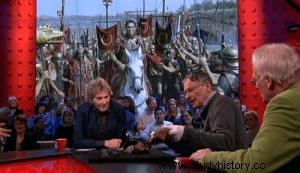
Dr. Roymans, could you explain to us what exactly you have found?
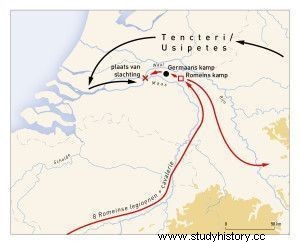
We have re-evaluated the aforementioned Caesar text in which recounts the massacre of the tencters and usipetes, which took place near the confluence between the Meuse and Rhine rivers, a veritable mousetrap in which the Germans had been trapped. The reconstruction of the old topography and the channels of both rivers, together with the data –revealed by César– that the confluence of both rivers was about 120 km from the coast, has allowed us to find the exact location where the this episode, specifically between the modern populations of Kessel and Lith. And, precisely in this place (at a point that was once part of the Meuse river) and on the occasion of recent drainage works, large quantities of lathenic-type weapons have been found, as well as human bone remains. Although the interpretation of this site is not without problems, as it lacks a clear and precise context, most of the material found seems to suggest an episode of a warlike nature, and may well be the reflection of a single episode. We cannot guarantee this with absolute certainty, but the characteristics of the human bone remains, as well as the metallic findings, support the hypothesis that we are facing a massacre scenario, such as the one that César describes in his De Bello Gallico.
Was there any previous indication or clue that would allow us to assume that the location of this episode was precisely this?
Some historians, including Emperor Napoleon III of France, already pointed out the possibility that the episode occurred among the aforementioned populations of Kessel/Lith and, as of 1970 , archaeological evidence began to be obtained that pointed in the same direction. However, to date no interdisciplinary study has been carried out that combines historical and archaeological data.
Is this discovery part of a larger project or investigation?
Yes, it belongs to a much larger project (co-directed by Professor Manuel Fernández-Götz, from the University of Edinburgh) dedicated to the study of the violence used during the Roman conquest of the northern Gaul and northern Hispania, as well as the influence this had, in social terms, on the indigenous populations.
And, regarding the reasons that led these Germanic peoples to emigrate towards the Rhine, do we know anything?
Caesar explains that both Tencters and Usipetes had been evicted from their lands by Suebi pressure. So, after wandering for three years in Germany, in the year 56/55 a. C. they decided to try their luck in northern Gaul.
What led Caesar to stop his advance and resolve to annihilate him?
The reason Caesar denied asylum to these Germanic tribes and then attacked them is understandable because the last thing he wanted was the presence, which would have been undeniably destabilizing, of a large group of immigrants in Gaul. His aim is to convince the reader that the Germans posed a serious threat to the security of Gaul. He presents himself as a protector of Rome and its northern provinces against the aggression of the Germanic peoples, a topic that in the Senate of Rome would evoke the memory of the invasion of Cimbri and Teutons, half a century earlier. /p>
What can we deduce from the human bone remains found at the site? Do they belong to men only or do they also include women and children, as Caesar's testimony suggests? Can we identify stab wounds on them?
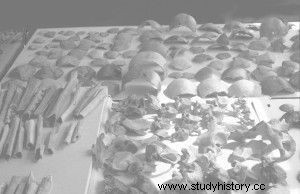
In total we have found 700 human bones, belonging to a minimum of 70 individuals. Carbon 14 analyzes indicate that most belong to the Late La Tène period. From the set of bone remains we can point out some striking data:it is a population both male and female, and with the presence of both adults and children. In addition, 15 bones show traces of injuries, which in some cases would be fatal of necessity.
Does the analysis of these bones allow us to extract information about the ethnic origin of these people?
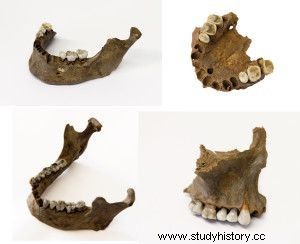
The dental remains of three individuals were subjected to a isotope analysis, in the ambition of discovering whether its origin was local or exogenous. To date, the results of these analyses, specifically their analysis of the presence of strontium in the teeth, indicate that none of them was native to the type of environment prevailing in the area during the Holocene; They must have come from somewhere else. A second set of bones is currently being analyzed in order to expand the sample and try to determine the starting point of these population groups.
In addition to human skeletal remains, you have found a large number of weapons. What type do they belong to? Are they weapons of the Germanic peoples, or can other different typologies be identified?
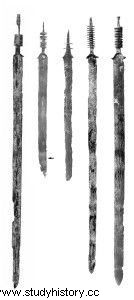
Among the Late La Tène finds documented in the ancient riverbed at Kessel/Lith there were 23 iron swords or scabbards, some spearheads, an iron helmet and 22 Germanic-type belt buckles. The swords correspond to a long-bladed model characteristic of cavalry (Kessel type) that includes numerous bronze discs arranged on the hilt, a formula that can be dated to the LT D2 (La Tène D2) stage. They are so identical to each other that they seem to have been produced in the same workshop. The same date is suggested by the 18 Kessel-type bronze belt buckles, which probably belonged to women's clothing. These are also very similar, and could just as well have been products of the same workshop. Finally, there is the iron helmet ornamented with motifs in the form of eyebrows and horns on the front, a piece that can be considered as a bipartite helmet of the Port type, with a ribbed neckguard. This type of helmet was used by the Gallic auxiliaries of the Roman army in the middle of the s. I a. C.
The complete absence of late Republican Roman military equipment is highly significant, though not entirely surprising, since the Romans managed to win with minimal losses; Caesar relates that not a single Roman soldier fell in battle!
Would it be possible, in light of the evidence, to identify the findings in relation to the combats between the Germanic and Gallic tribes that populated the territory, or would they fit Better off with Caesar's massacre of the Germanic camp?
Archaeological findings most likely suggest a link to the final episode of the massacre of the two tribes, with their mass flight towards the confluence of the Rhine and Meuse after the fall from their camp at the hands of the Romans.
On the other hand, the archaeological material of the battle at Kessel/Lith does not allow us to date it more precisely than in the LT D2 period, that is:between 80 and 30 a . C. approximately. This is what makes its connection with Caesar's campaign in 55 BC more plausible. C., although there is no absolute certainty about it. In theory, the archaeological remains could correspond to another battle fought in the same place and in the same period. What is certain is that we know that Caesar organized mass genocides against the Eburones in the same region between 53 and 51 BC. C., but these campaigns had a very different character, without major battles, since the Eburones opted for a strategy of total decentralization and diffusion.
In relation to the weapons found, do they correspond to a particular selection of objects of particular relevance, or could we say that they would be ordinary weapons, of the type that we would expect to find among the warriors of this time?
The weapons and ornaments that have been found do not include any specimen that we could consider exceptional. The swords appear to have been worn by a relatively small group of cavalrymen, while the belt buckles were probably worn by Germanic women.
Some of these weapons seem to show some voluntary folding and some kind of ritual treatment. Would it be possible to identify the remains as part of a trophy erected by the Romans after the battle?
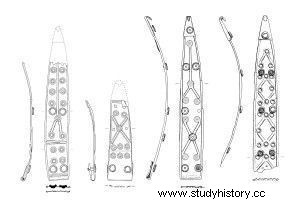
We can only speculate as to how human bodies washed up in the Meuse river. We can imagine a double scenario:on the one hand, the findings could reflect a battle in which a group of people were pushed into the river, where they were killed or drowned, as Caesar recounts. Another alternative scenario would be that of a deposition ritual after the battle and in which the bodies and weapons were collected from the battlefield by the survivors between the tencters and the usipetes, or by the Eburon inhabitants. I have previously interpreted this material as a complex ritual find due to the existence of ancient folds in the blades of some swords and its probable association with animal bones (many of them from bovines) and ceramics. A ritual interpretation of this kind does not at all contradict its relation to a battle; many remains of ancient battles have been the subject of later manipulation, and can often be found deposited in places of worship in Iron Age Gaul, such as at Ribemont-sur-Ancre or the La Tène site itself.
Were these types of events common at this time? Do we know of similar cases?
Historical evidence suggests that intertribal conflicts were rare but not unknown in Iron Age Western Europe. However, we lack historical data, for example regarding the conflicts related to the migrations of the Cimbri and the Teutons, and we are comparatively much better informed about the great battles related to the Roman conquest of Gaul. Undoubtedly, the growing interest in the field of conflict archeology will help substantially increase our understanding of large-scale military conflict in ancient societies.
What other projects do you have in mind for the future?
During 2016 we want to continue our research at Kessel/Lith, especially focusing on isotope analyzes of human remains. Also, I intend to work on the project on the Roman conquest of northern Gaul that I mentioned earlier.
Don't forget to check the issues of Desperta Ferro Antigua y Medieval related to this topic!
